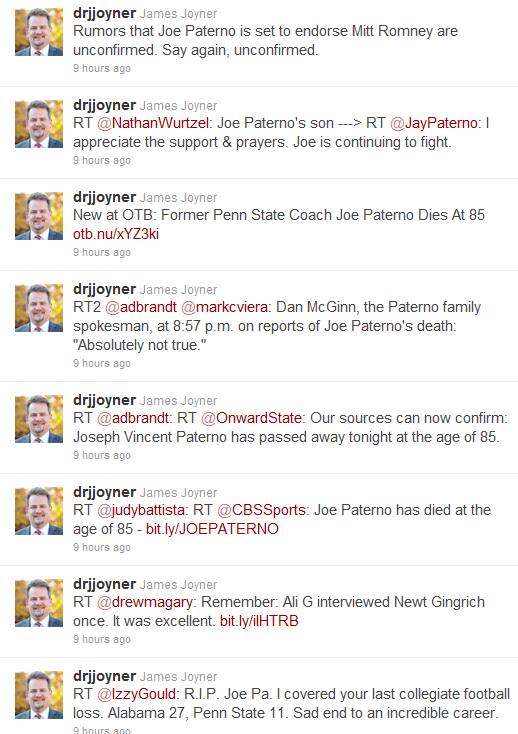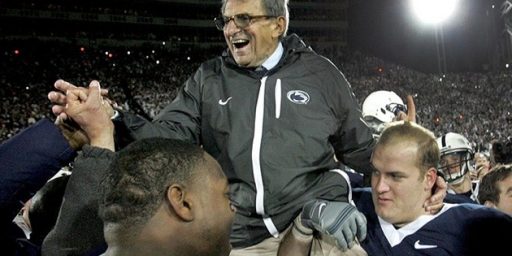Breaking and Unbreaking News in Twitter Time
Within an hour last evening, I passed along and retracted two breaking news stories on Twitter.
Within an hour last evening, I passed along two breaking news stories on Twitter. First, that former Florida governor Jeb Bush was set to endorse Mitt Romney ahead of that state’s suddenly very important primary. Second, that legendary but recently disgraced former Penn State football coach Joe Paterno had died. Within the next hour, I passed along news that both of those stories were premature.
While Twitter is at the low end of my diligence hierarchy–I’ll pass along (by re-tweeting) stories from trusted sources without verifying them, sometimes even without reading them–compared to blogging, much less more deliberately researched pieces written for publication elsewhere, that wasn’t my downfall in either case here. Both stories came from very solid support chains.
My re-tweet of the “Jeb Bush to endorse Romney” story re-tweets Stephen Hayes and Patrick Ruffini, well connected Republican analysts, and they were passing along a report from Josh Marshall’s well regarded Talking Points Memo which was passing along a CNN report.
I actually sent out three re-tweets in rapid succession on the Paterno story. First, Alabama sports journalist Izzy Gould‘s recollection that he’d covered Paterno’s last loss as a head coach, to the University of Alabama, last year. Then, NYT NFL writer Judy Battista‘s passing along of a CBS Sports report. Then, NFL business guru Andrew Brand‘s re-tweet of Onward State’s report “Our sources can now confirm: Joseph Vincent Paterno has passed away tonight at the age of 85.”
Both incidents demonstrate the nature of a Twitter stream: well-connected folks are connected to one another and things can go viral very quickly because of it. Bad reporting can spread in a matter of a few minutes. Thankfully, so can good reporting.
Poynter’s Jeff Sonderman examines “How false reports of Joe Paterno’s death were spread and debunked.” Essentially, Onward State, a Penn State student news website, broke the news at 8:45pm, noting that “Football players received an email minutes ago informing them of Paterno’s passing.” Local FM station Radio 94.5 apparently reported the story “around the same time.” This spurred CBS News and Huffington Post to rush to publish pre-prepared obituaries.
Those of us following people who follow these sources–which is to say, pretty much everyone likely to be on Twitter around 9 on a Saturday night–made the story go viral. But, Sonderman notes, “Minutes later though, other news organizations contradicted the reports, citing a family spokesperson. New York Times reporter Mark Viera appeared to be among the first.” Following that, “CBS Sports updated its obituary to include attribution to the Onward State report and a second paragraph noting contradictory claims. Other news organizations scrambled to react.” Soon, “Joe Paterno’s son, Jay, later tweeted his own report.” Finally, “Around 9:29, about 45 minutes after its first report, Onward State apologized to its Twitter followers.”
I never saw the Online State retraction but I did re-tweet several retractions, including the Jay Paterno tweet, in something close to real time. How quick did this all happen? Well, take a look at my tweets from last night:
Aside from the Ali G/Newt Gingrich tweet, seven successive tweets took me from the original Izzy Gould report to two others to Doug Mataconis’ OTB post passing along the news (which he unpublished in the space of maybe 5 minutes) to the “family spokesman” and Jay Paterno’s denials.
My last tweet on the subject for the night, “Rumors that Joe Paterno is set to endorse Mitt Romney are unconfirmed. Say again, unconfirmed,” may have been in questionable taste. But it reflects my bemusement over the whole thing.
Update (Doug Mataconis): As noted in the comments, Joe Paterno’s family reports that he passed way early this morning.







Where, oh where!, are the layers of fact-checkers on Twitter?
Seriously, though, I wonder if anyone has (or could) study the signal to noise ratio on Twitter?
@John Burgess: Ah, it’s doubtless high. I get got value because I filter well, following very high caliber people through managed lists. But even so, there’s a lot of chatter and useless speculation. I enjoy the social aspect of it, or else I’d likely adopt the strategy I do with presidential debates and speeches: Skip the live version and wait a couple hours for the written analysis.
@James Joyner: I found the S:N ratio discouraging even when social media was limited to telephones! Perhaps I should just wait until ten or more years after the fact to get ‘good’ analysis…
@John Burgess: Indeed. There’s a trade-off between timeliness and accuracy. Politics and sports junkies, alike, want constant information about things that will not require speculation in relatively short order. Elections will be held, games will be played, etc.
Interestingly enough, the original CBS Sports story on Paterno didn’t even make note of the fact that their source on the news was a student website rather than a hospital source. That changed within about five minutes after I’d first seen the story and written the post.
Of course things like this preceded the Twitter era. I recall the time when Bob Hope was declared dead on the floor of the House of Representatives.
@Doug Mataconis: Or James Brady was declared dead on ABC News during live breaking coverage of the Reagan assassination attempt. Breaking news environment the same regardless of medium.
@James Joyner:
Or NPR erroneously reporting that Gabrielle Giffords had died last January.
Well, your JoePa tweet was only a day premature.
What a sad ending.
Now I have to wonder if Paterno knew he had lung cancer even before the scandal broke and just didn’t announce it until after he was fired. The median survival time after diagnosis for lung cancer is 20 months, and 12 weeks from diagonsis to death seems extremely short.
If he was getting chemo all season, it would also explain why he was up in the booth instead of on the sideline for nearly all his games this year.
If true, the fact he would keep something that important to the future of the program to himself kind underlines how Paterno’s penchant for secrecy contributed to the Sandusky scandal.
If you’re trying to apologize or justify yourself, James, I don’t think that’s necessary. As Doug notes, these things happen. I don’t think anyone is going to hold it against you that you retweeted what ended up being a premature report.
Signal-to-noise is a bug and feature, but not the real culprit.
I’ve been compiling a chronology of the erroneous JoePa story. Feel free to read it here:
http://storify.com/kennysmith/joe-paterno/
Breaking or hot news scenarios often have poor signal-to-noise ratio. That’s why news outlets have frequently had embarrassing gaffes. Now they are just more public than ever.
Ultimately, Twitter amplified the problem: the absence of verification, earnest mistakes by student media and carelessness by a non-traditional component of CBS’s non-traditional arm. This could — and does, as we all know and you have cited above — happen in the traditional settings.
(Incidentally, as of this writing, the kids at OnwardState have been far more forthcoming than their professional peers.)
Humans, journalists, have the agency here.